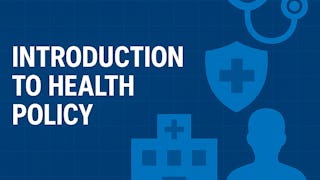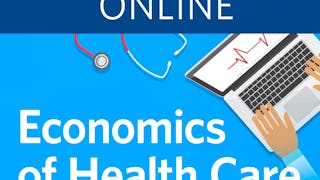This course is dedicated to public officials working in the areas of health policy and financing of services and specialists in economics, medicine and health law, academics (researchers, professors, students), opinion makers, and citizens interested in improving the effectiveness, quality and coverage of health services in their communities.

Enjoy unlimited growth with a year of Coursera Plus for $199 (regularly $399). Save now.

Skills you'll gain
Details to know

Add to your LinkedIn profile
33 assignments
See how employees at top companies are mastering in-demand skills

There are 7 modules in this course
When we ask ourselves “What to finance in health and at what price?", we do so in reference to the major objective that the United Nations has set for 2030: to achieve Universal Health Coverage (UHC). In this module, we will talk about UHC, its importance as a goal, and the difficulties that countries face in achieving it. We will explore the gap that exists between the infinite needs of the population and the limited financial resources of health systems. We will learn what the 5 key factors are that drive the increase in health spending at a much higher rate than income, which, in turn, increases the gap between resources and needs. Faced with this context, we will answer questions such as: What happens when there is a gap? How does it become apparent in people's daily lives? How can this gap be managed? You will have the opportunity to analyze your environment and examine how healthcare rationing is taking place in your surroundings, demonstrating the gap that exists. We will finish the module by addressing the importance of improving efficiency in health resource management in order to obtain greater benefits with the same budget while introducing the two tools that will make up the backbone of the rest of the course: explicit priority setting in health and tools that allow us to achieve more affordable medicine prices.
What's included
7 videos7 readings3 assignments1 discussion prompt3 plugins
In the previous module, we discussed the importance of making decisions that lead to improvements in the efficiency of health spending so that more benefits may be achieved with the same budget. Explicit priority setting is a fundamental approach that helps us move towards this goal. You will learn how to recognize its characteristics and how it is different from implicit priority settings. You will see that countries can implement these policies in different ways and with varying levels of specificity ranging from tools that only define general categories of coverage to health benefits packages (HBPs) which contain a high level of detail and guarantees for users. We will talk about these later in the course.
What's included
8 videos3 readings5 assignments1 discussion prompt1 plugin
HBPs are explicit priority-setting tools that allow countries to ensure coverage of the most important services based on efficiency and equity while keeping in line with the preferences of their population. In this module, we will explore in-depth what an HBP is and what are the most important reasons leading to its adoption. We will also go over the 10 steps required to design and adjust an HBP, various enablers for successful HBP policy implementation, and 8 basic characteristics that can vary from one HBP to another.
What's included
7 videos7 readings5 assignments1 discussion prompt2 plugins
To make an explicit coverage decision, consideration must be given to both the information generated by the evidence using analytical methods and the social and political factors that influence those decisions. In this module, we will first learn about the advantages of using analytical methods as a starting point for making explicit coverage decisions and the priority-setting criteria that is used to evaluate technologies. We will talk about Health Technology Assessment (HTA) as a process that validates health technologies with a view to making coverage decisions. We will also review 3 methods for analyzing them: cost effectiveness analysis (CEA), extended cost effectiveness analysis and the multi-criteria analysis. We will look at two strategies for supporting decision-making once the health technologies have been evaluated: the zero-based approach and the threshold approach. In the last part of this module, we will take a closer look at the main methods that allow us to identify the costs of prioritized health technologies and benefits packages (HBPs). We will see that costing is a necessary condition for ensuring the financing of prioritized services and as a result the financial sustainability of the coverage policy and the HBP. Besides, it is a major input to carry out cost-effectiveness analyzes and to design payment mechanisms and set rates. We will also understand how the results provided by analytical methods need to be analyzed and combined with other variables, such as context, social acceptance or equity. We will learn that far from simply being a scientific exercise, explicit priority-setting involves the use of social values and requires participatory processes to deliberate on the evidence. NOTE: In this module we will use the terms "medical technologies", "health technologies", "services and medicines" interchangeably to refer to "medicines, devices, medical and surgical procedures used in health care; and the organizational systems through which health care is delivered. In accordance, therefore, with this definition, which is widely accepted, health technology is not only machines or medicines, but also the clinical practice itself and the way it is organized" (Pupo et al. 2004)
What's included
18 videos10 readings7 assignments1 discussion prompt1 plugin
For an explicit priority setting process to be accepted by stakeholders, who will not always see all their preferences reflected in the coverage decisions, requires not only the use of analytical methods and the best possible evidence but also respect for ethical principles and the implementation of good governance principles. Additionally, political economy and the right to health should be taken into account as two dimensions that are likely to play a part in the processes.
What's included
6 videos6 readings6 assignments1 discussion prompt
An important part of the public health budget is allocated to pharmaceutical expenditure and the reality is that the prices paid for medicines vary considerably across countries and even within countries. Many low- and middle-income countries also often pay higher prices for medicines than others with greater economic resources. In addition, prices of specialized medicines are increasingly high and the relationship between these prices and the additional therapeutic benefits they offer over existing alternatives is not always clear. This situation implies a challenge not only for access to medicines but also for achieving Universal Health Coverage (UHC). We will start this module by reviewing some basic concepts in economics and types of medicines, which will help you understand the contents that will follow. We will move on to analyze the characteristics of the medicine market and the enabling conditions for competition which allow us to obtain more efficient and affordable prices. After this, we will explore some of the variables that determine the price of medicines, and we will finish the module by looking at a series of tools that countries can use to achieve more affordable prices. You will have the opportunity to learn about the experience of countries like Peru, Colombia, Brazil, Mexico, Germany, New Zealand, and Korea, which have implemented some of these tools and have valuable lessons to share with other countries.
What's included
19 videos8 readings7 assignments1 discussion prompt1 plugin
What's included
5 videos2 readings2 plugins
Instructors


Offered by
Explore more from Public Health
 Status: Preview
Status: PreviewO.P. Jindal Global University
 Status: Free Trial
Status: Free TrialImperial College London
 Status: Free Trial
Status: Free TrialUniversity of Michigan
 Status: Free Trial
Status: Free TrialUniversity of Pennsylvania
Why people choose Coursera for their career





Open new doors with Coursera Plus
Unlimited access to 10,000+ world-class courses, hands-on projects, and job-ready certificate programs - all included in your subscription
Advance your career with an online degree
Earn a degree from world-class universities - 100% online
Join over 3,400 global companies that choose Coursera for Business
Upskill your employees to excel in the digital economy
Frequently asked questions
To access the course materials, assignments and to earn a Certificate, you will need to purchase the Certificate experience when you enroll in a course. You can try a Free Trial instead, or apply for Financial Aid. The course may offer 'Full Course, No Certificate' instead. This option lets you see all course materials, submit required assessments, and get a final grade. This also means that you will not be able to purchase a Certificate experience.
When you purchase a Certificate you get access to all course materials, including graded assignments. Upon completing the course, your electronic Certificate will be added to your Accomplishments page - from there, you can print your Certificate or add it to your LinkedIn profile.
Yes. In select learning programs, you can apply for financial aid or a scholarship if you can’t afford the enrollment fee. If fin aid or scholarship is available for your learning program selection, you’ll find a link to apply on the description page.
More questions
Financial aid available,

